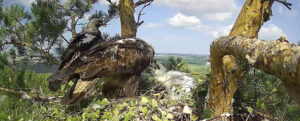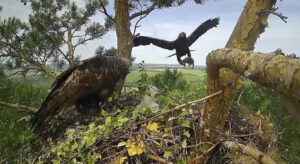Third International Scientific and Practical Conference “Eagles of the Palearctic: Study and Conservation”
Raptors Conservation. Suppl. 2. Proceedings of Conferences
Seasonal Aspects of the Diet of the Volga Population of the Eastern Imperial Eagle During the Breeding Season
Korepov M.V. (Ulyanovsk State Pedagogical University named after I.N. Ulyanov, the Sengileevsky Mountains National Park, Ulyanovsk, Russia)
Contact:
Mikhail Korepov korepov@list.ru
Recommended citation: Korepov M.V. Seasonal Aspects of the Diet of the Volga Population of the Eastern Imperial Eagle During the Breeding Season. – Raptors Conservation. 2023. S2: 300–304. DOI: 10.19074/1814-8654-2023-2-300-304 URL: http://rrrcn.ru/en/archives/35101
Diet is a key factor in determining the status of large raptor populations. Regional studies of the diet of the Volga population of the Eastern Imperial Eagle (Aquila heliaca) are mainly based on the collection of food remains and scats at nesting sites. This method allows a rather complete identification of prey species composition and in some cases their quantitative ratio, but seasonal aspects of prey spectra remain poorly studied.
Observations were made at an Imperial Eagle nest in the Cherdaklinsky district, Ulyanovsk Region (Zavolzhye), during three breeding seasons (2019–2021) from March to September. For this purpose, an outdoor surveillance camera with an autonomous power supply was installed near the nest. During the entire observation period, 555 food items brought to the nest by adult Imperial Eagles were recorded. Of these, 543 items were identified to species or genus level.
During observations over three breeding seasons (2019–2021), 30 wild vertebrate taxa, defined to species (26 taxa) or genus (4 taxa), belonging to four classes: ray-finned fishes, reptiles, birds, and mammals, were identified in the diet of a pair of Imperial Eagles. In addition, 4 species of pets were identified, belonging to two classes: birds and mammals. In terms of species diversity in the dietary spectrum, birds dominate with 19 species, including three species of domestic birds, followed by mammals with 9 species, including one species of domestic mammal, fish with 5 species and reptiles with one species. The main prey species of the Imperial Eagle at the study site are the Russet Ground Squirrel (Spermophilus major) (35%), the Rock Pigeon (Columba livia) (22%) and the European Hamster (Cricetus cricetus) (14%).
The intensity of prey capture by Imperial Eagles during the nesting season has a certain temporal dynamic related to the food requirements of the birds. In April and May, during the period of mating, nest building and incubation, the amount of food items brought to the nest is relatively low. In June, foraging intensity reaches a maximum, which is related to the hatching of chicks by early summer and the need to feed them regularly during the first few weeks of their lives. After that, the amount of food items brought in remains relatively high, but gradually decreases from June to September.
The main prey of the Imperial Eagle varies considerably from season to season. Rodents (the Russet Ground Squirrel, the European Hamster, voles, and mice) predominate during nest building (April), incubation (May) and chick growth (June and July). Meanwhile, the proportion of pigeons and corvids increases significantly at the end of the breeding season, during the feeding period of fully feathered chicks and fledglings (August and September).
The amount of food items brought to the nest during the nesting season varies considerably from year to year, depending on the number of chicks, the time they fledge from the nest, and the frequency with which the fledglings return to the nest before finally leaving for their wintering grounds. For example, in 2019, the only reared chick continued to feed at the nest until the end of September, whereas in 2020, another sole reared chick left the nest in mid-August and did not return, instead feeding at the roost. In 2021, both reared chicks stopped feeding at the nest in early September. At the same time, the amount of food items brought in for the whole season was 1.8 times higher in 2021 than in 2020, when chick feeding on the nest ended three weeks earlier, and 1.3 times higher than in 2019, when chick feeding on the nest ended three weeks later. Therefore, raising two chicks resulted in an average 1.5-fold increase in the number of prey items compared to raising a single chick. The increase in the number of food items when rearing two chicks was mainly due to rodents: the Russet Ground Squirrel, the European Hamster, and grey voles. Their consumption increased not only in June and July, when rodents dominate the eagles' diet, but also in August, when pigeons and corvids begin to dominate the diet in years with a single chick. Among the large rodents (ground squirrels and hamsters), the Russet Ground Squirrel dominated the diet in June and July with 96% (n=48) and 94% (n=33) respectively, whereas the European Hamster dominated in August with 80% (n=35).
This is important for understanding the distribution and abundance of the Imperial Eagle within the nesting range of the Volga population of the species. Despite the great plasticity of the species in its choice of prey (65 different species and breeds of vertebrates have been identified in the diet of Imperial Eagles in the Ulyanovsk Region alone), large rodents of open habitats remain one of the most important food items, generally dominating in terms of quantity and playing a particularly important role during the period of feeding chicks throughout their growth and feathering. It appears that this ecological prey group is the main factor determining the location of Imperial Eagle nesting sites and the breeding success of individual pairs.
The research was conducted as part of the "Study and Conservation of the Eastern Imperial Eagle" project carried out by the Non-Governmental Nature Conservation Centre "KAVKAZ” (NABU-Kavkaz) in cooperation with the Russian Bird Conservation Union (RBCU) and the German Nature and Biodiversity Conservation Union (NABU), with support from the NABU International Foundation and the VGP Foundation.

Pair of the Imperial Eagles on the nest: the female feeds the nestling. Photo from webcam by M. Korepov.

